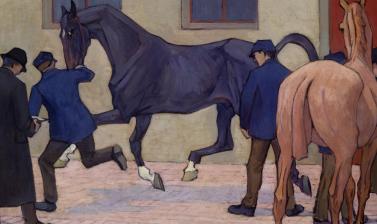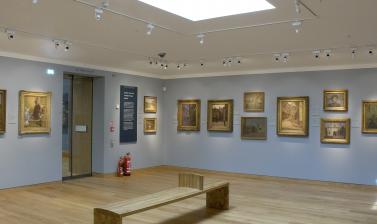SICKERT AND HIS CONTEMPORARIES
Walter Sickert (1860–1942) was one of the most influential and controversial artists of the 20th century. He was a pupil of James McNeill Whistler in London and then trained in Paris where he became friends with Degas and many of the Impressionists. Degas inspired him to capture the essence of daily life and Sickert wished his works to be like a ‘page torn from the book of life’.
He settled in London in 1905 and held informal gatherings of artists and collectors at his studio in Camden Town. These led to the formation of the Camden Town Group which held three exhibitions between 1911 and 1912; some of their works are displayed here. The members of the group chose as their subjects the suburban landscape and modest interiors of the time but painted in bold colours inspired by the Post-Impressionists such as Van Gogh and Gauguin on the continent. This is well illustrated by Spencer Frederick Gore’s Cinder Path where he paints the path linking the old town of Baldock to new town of Letchworth in a palette of pure Gauguin.
Sickert was a friend of the wealthy Sands family and Morton Sands and his sister Ethel were the most important collectors of Sickert’s work during his lifetime. Much of the Sands’ collection is exhibited here including Sickert’s portrait of Ethel, a wealthy heiress (the family fortune lay in her grandfather’s patent cure for dysentry) and artist herself. Other works, such as Ennui, show Sickert’s talent for portraying melancholy and a mood of general sadness. Brighton Pierrots, Sickert’s depiction of a live performance at the British seaside resort in August 1915 shows a crowd of listless onlookers and empty deckchairs as night falls. The writer Virginia Woolf described Sickert as ‘a novelist in paint’.
Bronzes and carvings by leading sculptors of the late-19th and early-20th centuries including Rodin, Epstein and Gill are displayed in the cabinet at the top of the stairs.













